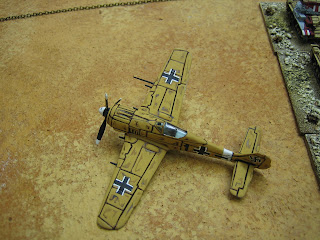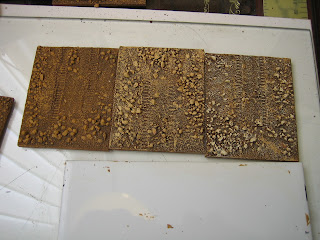Until yesterday I hadn't looked closely at the scenarios at the back of the book because I usually enjoy designing my own. But when I read the tenth one, entitled "Broken Spearhead - The Second Day at Sidi Rezegh" I suddenly realised that it was exactly what I was looking for for a combined deployment of 7th Armoured and 22nd Armoured brigades. Yes, I know, I said I couldn't field both together, but I was referring to the other scenario "Shiny Spearhead - The First Day at Sidi Rezegh". [grin]
I will use the map given in Benghazi Handicap (left) as the basis for my set up. It largely conforms to the more detailed map of the battle area in Sidi Rezeg Battles 1941 by Agar-Hamilton and Turner (below). This more detailed map clearly shows the strategic value of this strip of desert - it provides a way of getting a large force, travelling in formation, from the first escarpment to the summit of the third escarpment (it slopes upwards, west to east).
This (left) is my battlefield map. The escarpment is almost a copy of the one given in Benghazi Handicap, though mine is longer (bigger table - 10 x 6).
I have built the high ground into the line of the escarpment because it was described, when looking at it from the third escarpment, as forming the far side of a broad shallow valley. I have included the wadis running from the escarpment, which form the reentrants that will allow easy passage up it, but I have made them somewhat shorter above the second escarpment than they appear in the original scenario.
Although I have no idea where the escarpment's wadis would go, I have added a fictional wadi complex at the foot of the escarpment. This is an easy way to mark an east to west 'staggered' start line (roughly following the line of the escarpment at 800 - 1000m distance) for the Germans of Group Knabe to form up on.
I have removed almost all of the other high ground, especially that to the north of the escarpment - Belhamed is off table. Though geographically incorrect, I have introduced part of the third escarpment to give an indication that this piece of ground is a valley.

And here is how it all looks on my table.
TERRAIN NOTES.
- Except at reentrants, the face of the escarpment is type IV terrain and requires a difficulty check to climb or descend. The reverse slopes are type I terrain. Reentrants are type III terrain. They can be traversed in column or depth formation. The track to the aerodrome is type I terrain and can be traversed in column without penalty. The escarpments are a superior position when firing to lower elevations.
- The high ground on the escarpment is the highest ground in the battle area and counts as a superior position to lower elevations. High ground counts as an escarpment for movement.
- All wadis are shallow and do not have steep banks. Wadis are type II terrain to all moving along them (in column only) or crossing them. Wadis provide type II cover or hull down to units in them unless the fire is enfilading or from a superior position.
- The rough ground at the foot of escarpments is type II terrain.
- The buildings at the aerodrome do not block LOS. They have a three stand capacity. They provide type III cover. The wire around the aerodrome has been flattened during the previous two days fighting - it merely defines the area of the landing zone in a 'scenic stylie'.
I have largely, but not wholly, gone with Benghazi Handicap for the OOB. There are some differences in the force compositions to cater for my own tastes and my own choice of rules. As per usual, I have condensed them into organisational diagrams.
7th Armoured Brigade Composite Regiment: must deploy within the red boxed area on the scenario map.
3rd (anti-tank) Regiment RHA: At least one anti-tank battery of 3rd RHA must set up within the red boxed area on the scenario map. Other batteries can deploy anywhere south of the second escarpment and north of the third escarpment.
1st Battalion King's Royal Rifle Corps, A Coy. 2nd Rifle Brigade (attached): Can deploy anywhere south of the second escarpment and north of the third escarpment.
4th Field Regt. RHA: Deployed nearby to the south, off table. One battery is dedicated to Composite Regiment, 7th Armoured Brigade. One battery is a brigade asset for 7th Armoured Brigade.
22nd Armoured Brigade: Deployed to the south, above the third escarpment, off table.
GERMAN DEPLOYMENT NOTES
Group Knabe: Must deploy within the blue boxed area on the deployment map. All lorried Panzergrenadier companies start dismounted. Any or all artillery can be deployed unlimbered.
2nd Battalion, 155th Artillery Regiment: Two batteries are deployed to the north, off table. One battery is dedicated to 2nd Battalion, 104th Schuetzen Regiment. One Battery is dedicated to 8th Machine Gun Battalion. One Battery is attached to Group Stephan. It can be dedicated to one of the Panzer battalions of 5th Panzer Regiment or held as a brigade asset for Group Stephan. It can be kept off table or can be used for direct support.
408th Heavy Artillery Battalion: Deployed to the north, at Belhamed, off table. The FOO for these guns can be deployed with Group Knabe or Group Stephan. (Note: Belhamed is 25m higher than the Trig Capuzzo). The guns are a corps asset.
Group Stephan: Deployed to the north, around Belhamed, off table.
For the time being, I will end this blog post here. I will add more scenario information, including two short player briefings and the victory conditions, after the two players have got the game under way - I don't want to give everything away to both player's at this point (Peter and Graham occasionally read this blog).









































